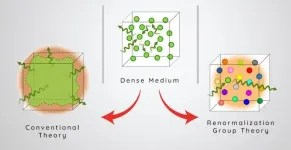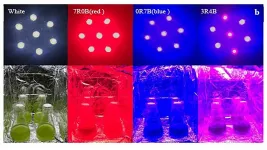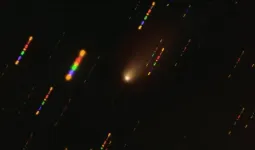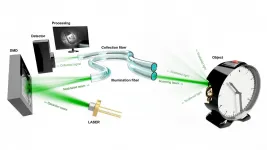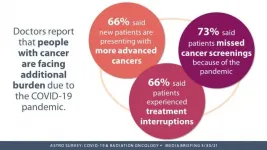Bespoke neuroblastoma therapy weaponizes cell metabolism
New mouse study shows that combining a new drug with an old one could exploit the insatiable "hunger" of a deadly childhood cancer
2021-03-30
(Press-News.org) Preclinical research from VCU Massey Cancer Center published recently in the Proceedings of the National Academy of Sciences shows that the combination of two existing drugs can exploit the metabolic "hunger" of a particularly aggressive type of neuroblastoma to kill cancer cells without inflicting too much collateral damage to healthy tissue.
Neuroblastoma - a type of cancer that strikes the nervous system of very young children - is one of the deadliest pediatric cancers. And children whose neuroblastoma overexpresses the gene MYCN tend to have the worst prognosis.
While medical advancements have led to high cure rates among pediatric blood cancers, neuroblastoma has proven much more challenging to treat, largely because the gene that makes this cancer so deadly is a tough one to target.
"MYCN is a transcription factor, and it's very difficult to drug transcription factors," said study senior author Anthony Faber, Ph.D., co-leader of the Developmental Therapeutics research program and Natalie N. and John R. Congdon, Sr. Endowed Chair of Cancer Research at VCU Massey Cancer Center and associate professor in the Philips Institute for Oral Health Research at the VCU School of Dentistry. "So, the next best thing is to target what MYCN does in the cell. One thing it does is to crank up metabolic activity - what it's doing to keep the cell alive - and we can work that against itself."
These neuroblastoma cells exist on the brink of metabolic overdrive, gobbling up energy stores as quickly as the cell can replenish them, so Faber's team sought ways to push these cells over the edge, without harming normal cells in the process.
The researchers screened 20 metabolic drug combinations in cancer cells originating from nearly 1,000 different patients and found that neuroblastoma with high MYCN expression was particularly sensitive to a cocktail containing two drugs: phenformin and AZD3965.
Phenformin, which blocks complex I on the surface of mitochondria - the sub-cellular compartment where energy production occurs - was developed in 1957 to treat diabetes. Although the Food and Drug Administration took phenformin off the market in the 1970s following a string of deaths, it's still in use elsewhere in the world and is starting to make a comeback in the U.S. as a cancer drug. Right now, phenformin is being tested in a phase I clinical trial for melanoma.
AZD3965, a much newer type of drug that blocks MCT1 rectors on the surface of cells, is also under phase I clinical investigation, in this case as a treatment for many different types of cancer. MCT1 receptors ferry lactate - another source of energy - out of the cell. But when MCT1 is blocked and lactate accumulates, the cell stops using it to make energy.
Since the receptors targeted by phenformin and AZD3965 participate in energy production through two distinct pathways, blocking them both at once should dramatically disrupt the cellular power supply, leading to stress and ultimately cell death.
Faber's team tested this idea by using mice seeded with MYCN-amplified neuroblastoma patient cells and found that animals treated with both drugs saw greater tumor shrinkage than animals given either drug alone, and the cocktail was well tolerated.
"The data we got with AZD3965 in combination with phenformin might get people to reconsider phenformin," said study lead author Krista Dalton, M.Eng., a Ph.D. student in the VCU Philips Institute for Oral Health Research. "In combination, where we can use lower doses, phenformin might have better tolerability than it previously did on its own."
INFORMATION:
Funding for this project was provided by the National Cancer Institute (R01CA215610-01) and Massey's NCI Cancer Center Support Grant (P30 CA016059).
Additional authors on the study include VCU researchers Timothy Lochmann, Ph.D., Konstantinos Floros, Ph.D., Marissa Calbert, Richard Kurupi, M.S., Sosipatros Boikos, M.D., member of Massey's Developmental Therapeutics research program, Mikhail Dozmorov, Ph.D., member of Massey's Cancer Biology research program, Sivapriya Ramamoorthy, Ph.D., Madhavi Puchalapalli, M.S., Bin Hu, Lisa Shock, Ph.D., Cancer Biology member at Massey, Jennifer Koblinski, Ph.D., director of the Cancer Mouse Models Core and Cancer Biology member at Massey; Giovanna Stein, Joseph McClanaghan, Ellen Murchie, Regina Egan, Patricia Greninger, and Cyril Benes, Ph.D., of Harvard Medical School; and John Glod, M.D., Ph.D., of the National Cancer Institute.
[Attachments] See images for this press release:
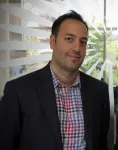
ELSE PRESS RELEASES FROM THIS DATE:
2021-03-30
LOWELL, Mass. - Too often, contends UMass Lowell faculty researcher Brenna Morse, children with complex chronic medical conditions spend days in the hospital undergoing tests for what could be a simple diagnosis.
The challenges include, she says, some children with medical complexities, such as severe neurological conditions and functional impairments, cannot easily signal that they are in pain or point where in their body it is located. Where children not facing such a challenge might be able to have a medical issue resolved with a simple visit to their primary care doctor, others end up hospitalized and going through days of costly testing to arrive at similar diagnoses.
Morse, a UMass Lowell ...
2021-03-30
Pink Floyd's Dark Side of the Moon cover, voted the greatest classical rock album of all time, intended to portray the prism and dispersion of light into a rainbow as a certain metaphorical symbolism and a light show that was never celebrated. However, they really were not aware of the fact that this image would be used by many to help illustrate the concept of refractive index and how light changes speed and direction when it encounters a different medium.
Although conceptually the drawing was not accurate, it conveyed the message that light changes its speed when it moves into another medium, and that the different speeds of different colors causes white light to disperse ...
2021-03-30
Sausalito, Calif. (March 30, 2021) - After more than three decades of research, scientists have proven that the cancer affecting up to one in four adult California sea lions necrospied at The Marine Mammal Center in Sausalito, CA, is caused by a sexually transmitted herpesvirus. The cancer, known as sea lion urogenital carcinoma, has clear parallels to cervical cancer in humans and provides a helpful model for human cancer study.
Scientists have long suspected this cancer was associated with a virus, but this is the first study to prove this theory. The study, which was published in Animals, an open-access, peer-reviewed journal, concluded that genital herpesvirus is ...
2021-03-30
WASHINGTON, March 30, 2021 -- Emerging technologies can screen for cervical cancer better than Pap smears and, if widely used, could save lives both in developing nations and parts of countries, like the United States, where access to health care may be limited.
In Biophysics Reviews, by AIP Publishing, scientists at Massachusetts General Hospital write advances in nanotechnology and computer learning are among the technologies helping develop HPV screening that take the guesswork out of the precancer tests. That could mean better screening in places that lack highly trained doctors and advanced laboratories.
Cervical cancer is the world's fourth-most common cancer, with more than ...
2021-03-30
WASHINGTON, March 30, 2021 -- As ethanol, biodiesel, and other biofuels continue to present challenges, such as competing with food security or lacking the technology for more efficient and low-cost production, microalgae are gaining momentum as a biofuel energy crop.
In their paper, published in the Journal of Renewable and Sustainable Energy, by AIP Publishing, Yangzhou University researchers in China show how a combination of monochromatic red and blue LED illumination on one type of microalga can enhance its growth and increase the biosynthesis of critical components, such ...
2021-03-30
New observations with the European Southern Observatory's Very Large Telescope (ESO's VLT) indicate that the rogue comet 2I/Borisov, which is only the second and most recently detected interstellar visitor to our Solar System, is one of the most pristine ever observed. Astronomers suspect that the comet most likely never passed close to a star, making it an undisturbed relic of the cloud of gas and dust it formed from.
2I/Borisov was discovered by amateur astronomer Gennady Borisov in August 2019 and was confirmed to have come from beyond the Solar System a few weeks ...
2021-03-30
WASHINGTON, March 30, 2021 -- Scientists are developing tools to observe the biological machinery in in vivo animal models to be able to understand and better treat severe brain diseases like Alzheimer's disease and many other conditions. Holographic endoscopes attracted researchers' interest because of their potential to conduct minimally invasive observations inside the human body.
These tools can shed light on the biological processes occurring at the macromolecular and subcellular levels, which usually remain hidden from sight as most tissue is opaque to visible radiation. In APL Photonics, by AIP Publishing, researchers from the Leibniz Institute of Photonic Technology in Germany created a particularly narrow ...
2021-03-30
It makes evolutionary sense for long-lived animals to have complex social relationships - such as friends and enemies - researchers say.
Some species and individuals focus their energy on reproduction (live fast, die young), while "slow-living" animals prioritise survival and tend to live longer lives.
In the new paper, University of Exeter scientists argue that natural selection favours complex social structures among slow-living animals - meaning that knowing their friends and enemies is easier for animals with longer lifespans, and helps them live even longer.
Meanwhile, fast-lived species should only bother with such social relationships if it increases ...
2021-03-30
What The Study Did: Researchers investigated COVID-19 vaccine intentions among racially and ethnically diverse samples of health workers and the general population in the San Francisco Bay area.
Authors: Kevin Grumbach, M.D., of the San Francisco General Hospital and University of California, San Francisco, is the corresponding author.
To access the embargoed study: Visit our For The Media website at this link https://media.jamanetwork.com/
(doi:10.1001/jamainternmed.2021.1445)
Editor's Note: The article includes conflict of interest and funding/support disclosures. Please see the article for additional ...
2021-03-30
ARLINGTON, Va., March 30, 2021 -- Doctors who oversee cancer clinics say that new patients are arriving for treatment with more advanced disease than before the COVID-19 pandemic, according to a new survey from the American Society for Radiation Oncology (ASTRO). The national survey of radiation therapy practice leaders fielded this winter also indicates that treatment postponements and deferrals that were common a year ago have largely subsided and that clinics continue to use a variety of enhanced safety measures to protect their patients and staff.
"One year into the COVID-19 pandemic, we already see the consequences of pandemic-driven drops in cancer screening and diagnostics," said Thomas J. Eichler, MD, FASTRO, ...
LAST 30 PRESS RELEASES:
[Press-News.org] Bespoke neuroblastoma therapy weaponizes cell metabolism
New mouse study shows that combining a new drug with an old one could exploit the insatiable "hunger" of a deadly childhood cancer

